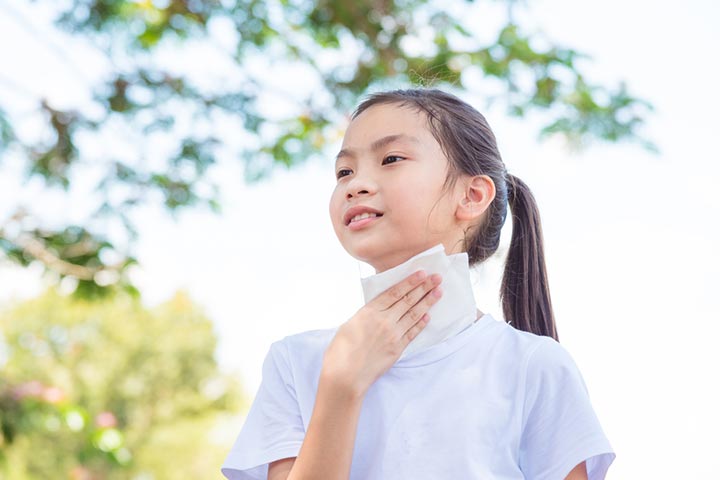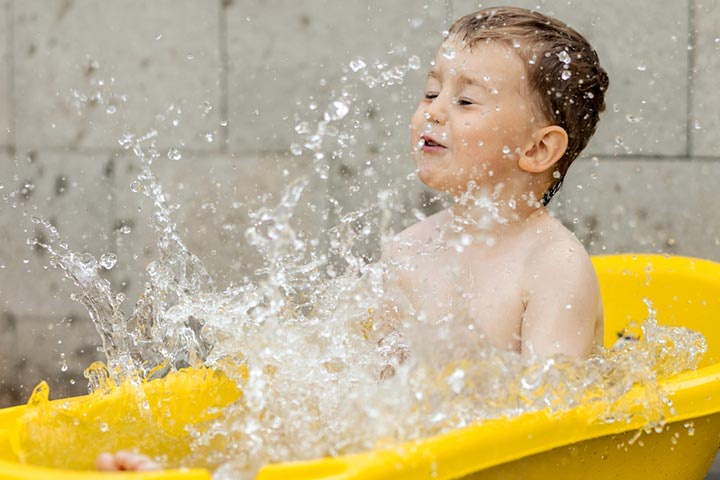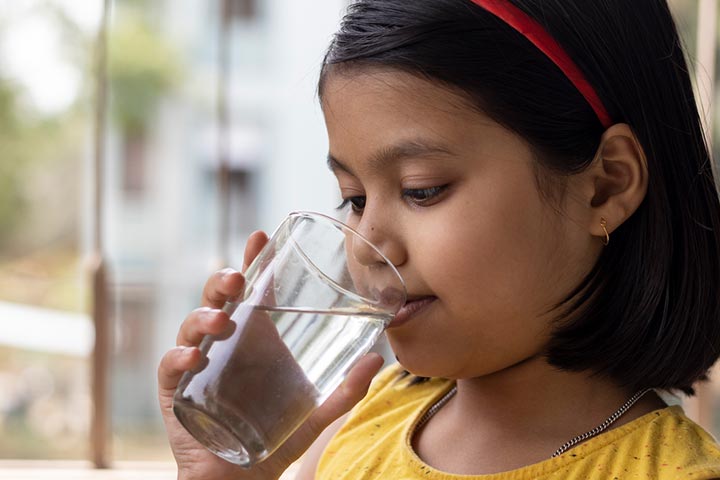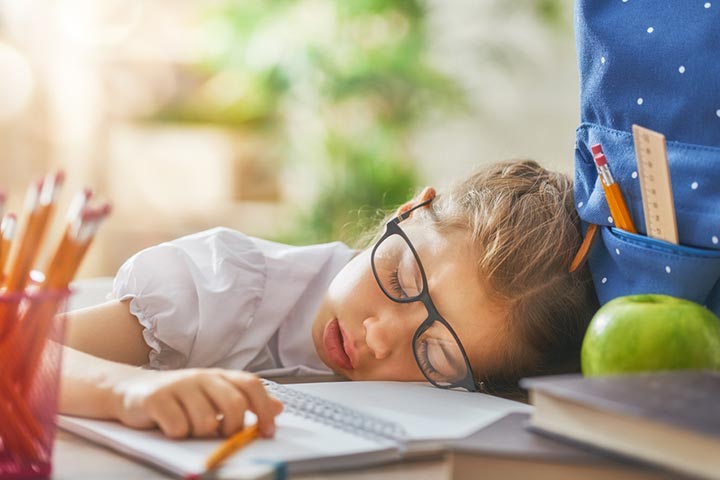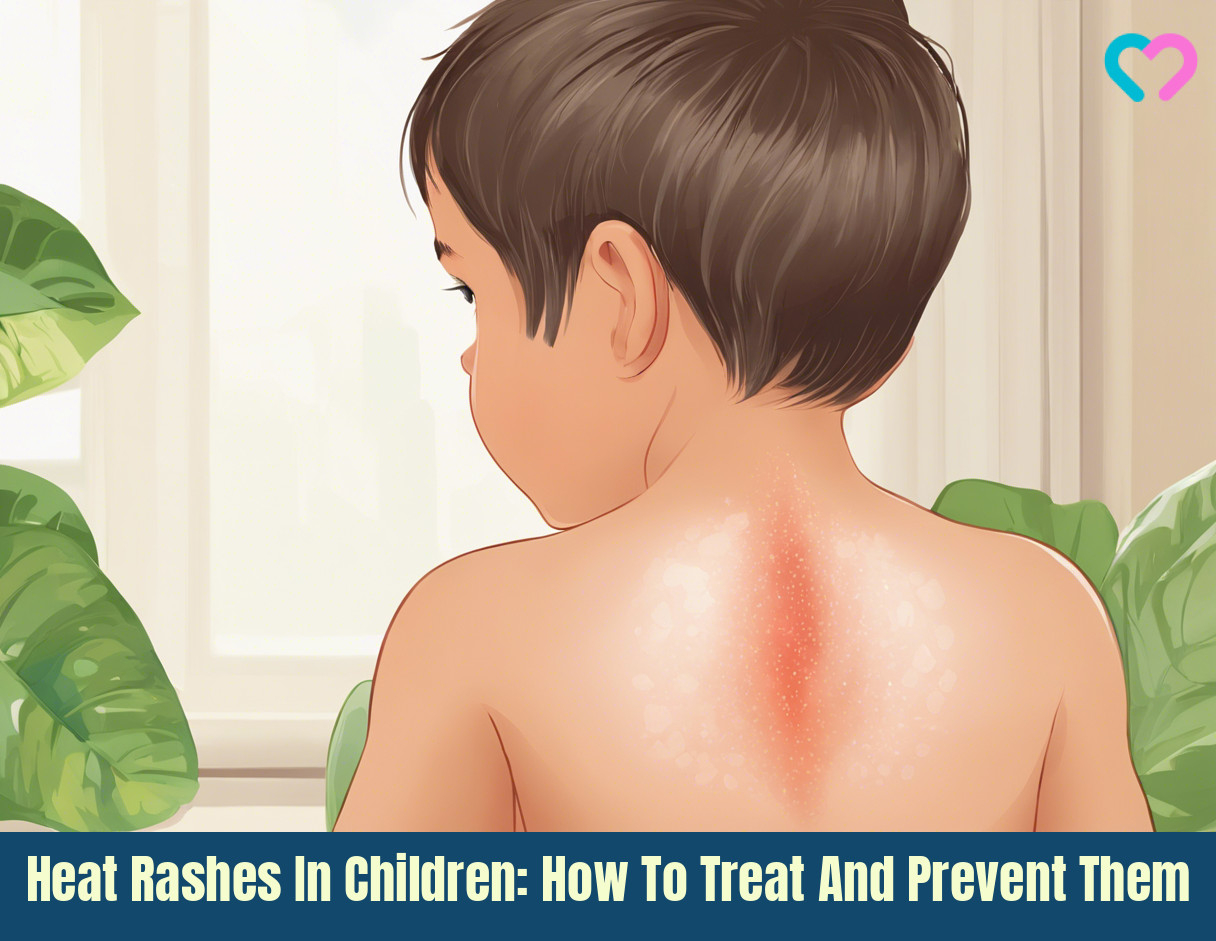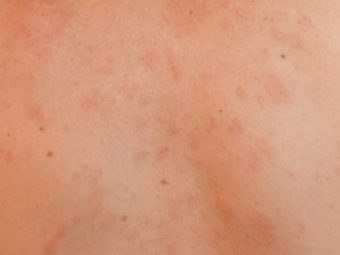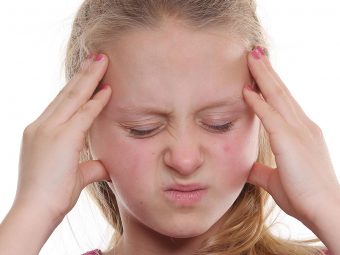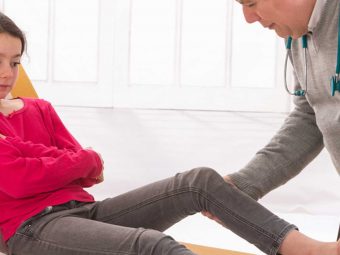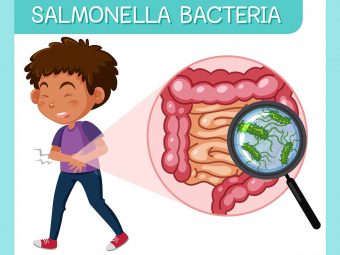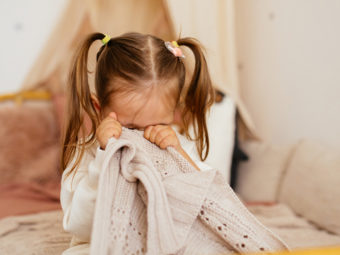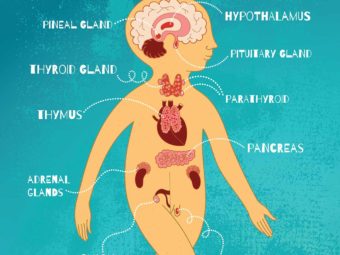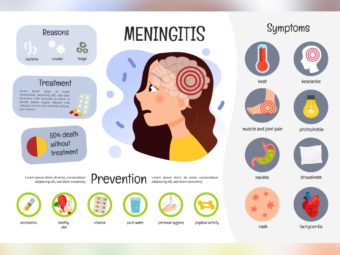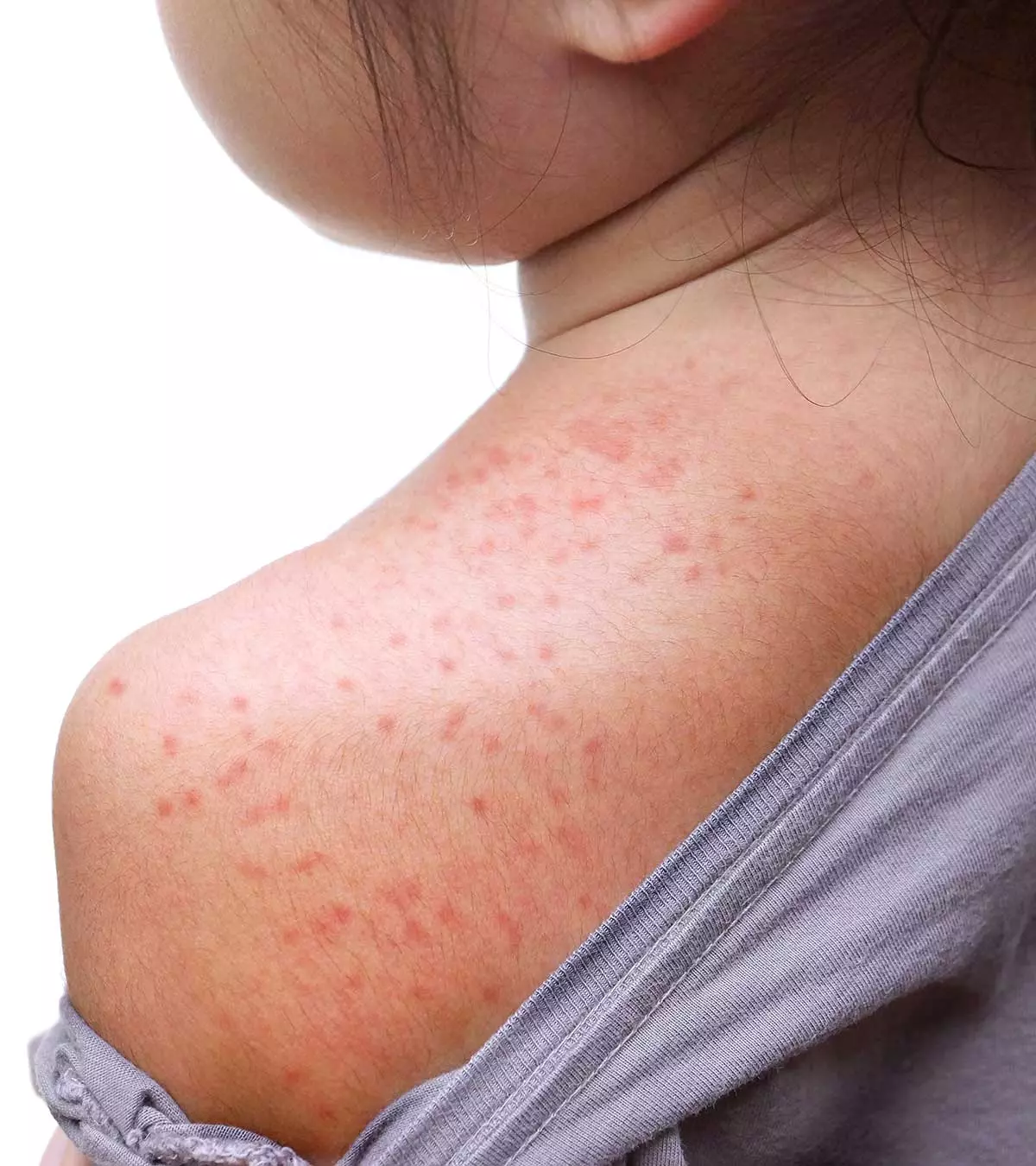
Image: Shutterstock
Heat rashes in children may be of many types and cause skin irritation. Thankfully, it is not considered a serious condition. These rashes usually affect the skin in the body parts that remain sweaty for a long duration. They are self-limiting and get resolved in a few days (1).
Continue reading this post as we tell you about the various types of heat rashes, the causes of heat rashes in children, their symptoms, and some home care tips for managing and preventing such rashes.
Types And Symptoms Of Heat Rashes
1. Miliaria rubra
- This appears as pinkish or red bumps without any pus.
- These are a few millimeters in size and appear as blisters.
- The bumps or hives appear on the fold of the neck, forehead, and creases of the elbow and knee.
- They also appear in the armpits and groin areas (2).
These tend to go away after a few days when the body temperature comes to normal.
 Quick fact
Quick fact2. Miliaria crystallina
- Is the least severe of the three types.
- Occurs in neonates as their sweat glands are yet to mature.
- 1-2 diameter bumps with clear liquid appear on the neck, axillaeiXA region in the human body below the shoulder joint where it connects to the arm , and face (3)
Cooling down the body and avoiding excessive clothing will reduce the rashes within a few days.
3. Miliaria profunda
- It is not common in children and might develop if miliaria rubra is ignored.
- Flesh-colored larger bumps appear on the skin.
- They might itch a little (2).
Sometimes, these rashes might require a visit to the doctor. But first let us see what causes heat rashes in children?
Causes Of Heat Rashes
A heat rash occurs due to the trapping of sweat within the sweat pores, and the blocking the sweat gland. These clogged sweat glands and sweat blockage can eventually lead to inflammation, blistering, and skin eruptions. Here are a few reasons which might cause blockage of the sweat pores.
- Hot weather is the leading cause of heat rash allergy. It causes sunburn in a child and makes them sweat more than usual, thus exacerbating the chances of a heat rash (4). A mother who blogs under the name Kiasumom says, “We noticed some rashes around Hayley’s (her daughter) feet and body. The heat rash appeared out of the blue and then suddenly disappeared. Initially, we thought it was a food allergy, but we did not recall giving her anything strange or new prior to the symptoms. After monitoring her for a few days, we noticed that she will get the rashes more when she is hot, that is, in the afternoon, and they will get better after she has had her bath (i).”
Image: Shutterstock
- High humidity also leads to sweating, slowing down the evaporation of sweat, and causing it to stay on the skin longer.
- Overdressing, with too many layers of clothes or tight clothes, in warm weather can cause excessive sweating and heat rash (5).
Image: IStock
- Intense exercise and playing outdoors make children sweat a lot more than they do indoors. Intense physical activity can increase the chances of the child getting a heat rash (6).
 Did you know?
Did you know?Heat rash, also known as prickly heat and miliaria, would get resolved within three to four days as soon as your child’s body cools down. However, it can cause itchy skin and prickliness that could irritate the children. Read on to how you may speed up the healing process.
Home Care And Prevention Of Heat Rashes In Children
Most cases of prickly heat do not require a visit to a doctor or medication. You can take remedial steps at home when you notice heat rash. These home care tips focus on preventing the accumulation of sweat and cooling your child’s body.
- Dress in fewer layers of clothing: Heat rashes might occur due to poor evaporation of sweat. Therefore,
- Dress your child in fewer layers of clothes made from natural fabrics like cotton. Cotton absorbs sweat and allows ventilation.
- If your child has a heat rash, you could consider letting them wear only one layer of clothing to let the body stay cool.
- Give a cool bath:
Image: Shutterstock
- Cool baths might help soothe itching and the prickly feeling caused by a heat rash.
- Let the child have a bath with cool water, without soap or shower gel.
- Keep the water cool to touch and not too cold since that can cause chills.
- Pat dry the skin with an absorbent towel and let the child stand under a fan to allow the rest of the water to dry.
- Keep ambient temperature cool:
- Keep the fan running at maximum speed in your child’s room during summers.
- If it is hot and very humid, then use an air conditioner to make the temperature comfortable enough to prevent excessive sweating and subside any existing heat rashes.
- Use prickly heat dusting powder:
- Several over-the-counter prickly heat dusting powders help contain itching and absorb sweat.
- Buy a prickly heat powder that is safe for your child’s age and apply the powder on the affected/prone areas.
- Dry off after exercise:
- Let the child stand under the fan after coming back from the outdoors. It helps evaporate the sweat, thus mitigating the chances of prickly heat.
- Plenty of liquids:
Image: IStock
- Give your child plenty of water to drink, as that could help bring down the body temperature and prevent dehydration.
If the itching is severe, then make an appointment with your child’s doctor.
 Quick tip
Quick tipWhen To Take A Child To A Doctor?
Image: Shutterstock
If the rashes do not subside with three to four days and if the following symptoms accompany a heat rash, then take the child to a doctor:
- Fever
- Excessive itching
- Vomiting and diarrhea
- Extreme lethargy or dizziness
- Loss of appetite
- Pus in the blisters
- Swollen lymph nodes
Frequently Asked Questions
1. What can be mistaken for heat rash in children?
EczemaiXAn inflammation of the skin accompanied by itchiness and dryness commonly triggered by an allergen in younger children and urticariaiXAn itchy skin rash in response to allergenic food, specific medicines, cold, or temperature change are commonly mistaken for heat rash in children, as these conditions are often aggravated by heat (7).
2. What cream is best for heat rash in children?
1% hydrocortisoneiXA corticosteroid medicine responsible for reducing swelling, itching, and pain cream could help relieve irritation due to heat rashes. However, consult a doctor before its usage to avoid side effects (8).
3. Is aloe vera good for heat rash in children?
Yes. Aloe vera in skin care has soothing healing properties, which can provide relief from itching and heat rashes in children and adults (9).
Heat rashes in children are mainly caused by humidity and excessive sweating. Although they get resolved by themselves within a few days, if your child shows signs of fever, loss of appetite, and the blisters start to produce pus, contact the doctor immediately. Doctors may advise you to dress your child in light and breezy clothes and not overdo the layers as they might increase the risks of heat rash. Also, keep your child in a cool and breezy environment and keep them hydrated to aid their recovery from the rashes.
Infographic: Heat Rashes Care And Prevention In Children At Home
Children frequently get heat rashes, which are mainly caused due to blocked sweat glands. These heat rashes can lead to itching, irritation, and discomfort in the child. So, check out the infographic below to explore effective ways to manage and prevent heat rashes in children. Illustration: Momjunction Design Team
Key Pointers
- Heat rash is a self-resolving condition that is often caused by excessive sweating.
- Heat rashes are classified into Miliaria rubra, Miliaria crystallina, and Miliaria profunda based on symptoms and severity.
- Major causes of heat rashes include hot and humid weather, overdressing, and intense physical activity leading to excessive sweating.
- Comfortable dressing, ambient temperature, adequate hydration, use of prickly heat powder, and cool baths can provide relief from itchy heat rashes.
- If children have persistent rashes accompanied by fever, excessive itching, diarrhea, lethargy, or swollen lymph nodes, they need to be evaluated by a doctor.
Image: Stable Diffusion/MomJunction Design Team
Learn how to prevent and treat heat rash in babies. Get tips on how to keep your baby cool and comfortable, and what to do if they develop a rash.
Personal Experience: Source
MomJunction articles include first-hand experiences to provide you with better insights through real-life narratives. Here are the sources of personal accounts referenced in this article.
i. Help! My daughter got heat rash!;https://kiasumom.blogspot.com/2010/08/help-my-daughter-got-heat-rash.html
References
1. Karla C. Guerra; Karthik Krishnamurthy; Miliaria; NCBI
2. Manju Nagpal, et al.; Miliaria-An Update; Research Gate
3. Sudhir Dixit, Ashish Jain, Suhas Datar, and V.K. Khurana; Congenital miliaria crystallina – A diagnostic dilemma; NCBI(2012)
4. A. Gilman, Miliaria Crystallina; Stanford Medicine
5. Carter R 3rd, Garcia AM, and Souhan BE; Patients presenting with miliaria while wearing flame resistant clothing in high ambient temperatures: a case series; NCBI(2011)
6. Andrew W. Nichols; Heat-related illness in sports and exercise; NCBI(2014)7. Jordyn Imhoff; How to Manage Your Summer Rash; University of Michigan
8. Heat Rash; Seattle Children’s Hospital
9. Top 10 Home Remedies for Prickly Heat; JKYog Natural Cure





